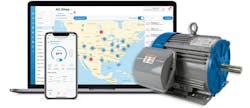The status of drone technology in security
In 2013, while working in the Bahamas, I observed what is now called a drone. As a security practitioner, my ‘paranoia propeller’ on my tin hat really started spinning. Later that year, I asked my wife to purchase a DJI Phantom FC40 drone with a Wi-Fi-enabled camera that worked with an iPhone 5. Like most men, when I received my new gift, I tore into it like the kid from "A Christmas Story" opening his Red Ryder BB gun.
Who needs instructions, I thought? However, I needed the instructions, and soon found a quick start guide, which instructed me to toggle the switches back and forth and listen for tones and lights. While I did that, I needed to rotate the drone on a vertical and horizontal axis. Once the ceremonial process was complete, the light on the drone turned green and the propellors pulled the machine into the air. The first thing I did was to push this thing as high as possible and within seconds I no longer could distinguish the drone from the clouds. Throttling back, I brought the drone to about 20-feet and pushed it forward horizontally.
Soon, I realized how hard it was to control the drone because it really does not have specificity to its directional travel, and there is the real possibility that turning left could be straight and vice versa. Within minutes, I no longer could see or hear the drone, and was startled by my wife who said, “You did not lose the $800 drone, did you?”
With my fingers off the controller, I walked toward the last sighting of my drone, hoping to hear the reverberation of the propellers. Nothing, and it became apparent that I lost this device. After searching for 10 minutes, I was losing all hope, when suddenly and faintly I heard the “buzz” of the propellors, which then became louder. I was excited but then upset, as the drone flew over me and headed back towards my house. Running frantically after the device, I wondered, did someone hack it? Why is it doing this? On the precipice of a heart attack, I watched the drone stop, hover and slowly descend to exactly where I previously launched it. That’s when I knew that this was not an IKEA build and that I would need to read the instructions fully.
Drone Technology
While we typically associate drones with quadcopters, the fact is that drones also include fixed-wing (airplane), single rotor (helicopter) and dirigibles, all with different uses, flight times and payload potentials. Presently, drones do not encompass ground/water-borne devices, but I think this will change with the rapid development of robotics. The absolute key foundation of flying drone technology is the use of global position systems (GPS), which use signals from thirty-one satellites to pinpoint any location in a spatial area. Without GPS, these drones would not lock their position, and also, we would not see the power and aerobatics that these little tiny motors can produce. Drones are a concern because there are very simplistic builds with commercially available parts. These parts include.
- Controller: This is what you used to control the drone. Typically, there will be flight sticks, toggles, which can disable GPS lock and return to home features.
- Receiver: This takes the commands from the controller in your hand. The controller captures the flight stick movement up/down and right/left and sends it to the receiver on the drone.
- Flight controller: Connected to the receiver, the onboard drone flight controller integrates with the onboard GPS Receiver and cameras which is why the drone stays put on a windy day and when the battery is low, will return to home. The integration of the camera also permits it to avoid obstacles.
- On-board GPS receiver: This intakes satellite data and relays that to the flight controller which controls the electronic speed controller and keeps the flight craft stable.
- Wi-Fi/Bluetooth or near-field communication antenna: This permits the drone to connect to a phone/tablet-based app. Flight telemetry can be downloaded, and waypoints and program functions uploaded. Thus, once the program is uploaded, the drone can autonomously operate with no user intervention these also can be called modes.
- Camera: The camera provides the opportunity for more intuitive control, and first-person-view (FPV). Since 2017, drones have had Integrated onboard cameras with motion tracking, obstacle avoidance that can communicate with the flight controller and adjust flight paths when under autonomous operation to avoid trees/houses. Cameras are typically using a separate wireless signal from that of the onboard receiver.
- Battery: There are sized for payload (camera, etc.) and flight time. The battery will connect to the electronic speed control circuit (ESC). The ESC is the voltage regulator that takes input from the flight controller to keep the drone in one location or to move it based on controller input. Essentially, this is just a power regulator. More power means more lift, less power, less lift, or directional movement. There will be one ESC per motor and the marriage between other ESC’s permits the device to turn or do flips (when GPS autopilot) is turned off.
The predecessor to my DJI FC40 is the DJI Mavic. The Mavic is a much smaller profile, which can travel up to 60+ miles per hour with 20–35-minute flight time and can be controlled up to six miles away. Hobbyist drones, using commercially available parts Frankenstein their drones together to address mission-specific objectives. Examples include drones that can carry much larger payloads or can be controlled through cellular networks for flight over infinite distances.
The Future of Drone Technology
We have only glimpsed the potential for drones. Advances in the future, along with their simplicity, will propel their use. Here is a glimpse of what the future holds.
Laws
There really are no practical, state, or federal laws that address drones. Most laws are handicapped by a federal law, which makes it illegal to interfere with a flight craft. To address the drone threat, the Federal Aviation Administration expanded its 2016 laws with a more simplified 400-page law, which seeks to monitor all drone craft through a remote identification (RID) device, which must transmit GPS, velocity, altitude, longitude, geometric altitude and time/date data to a receiving location. In my opinion, the system only keeps the honest people honest and does nothing to address the potential threat.
Threat
The threat is real and is almost expected, like when you are driving down the road and you see an erratic driver weaving into and out of lanes. As you observe this erratic behavior, you think to yourself he is going to get pulled over by the police, or he is going to cause an accident. Later down the road, you see the familiar red/blue strobing of the police stopping the offending vehicle at the predicted traffic stop. That’s where we are at with drone technology. The advancements of drone technology cement the validity in the statement that “it is not if, but when” drones will be used in the commission of an event. Until then, we will just have to keep our focus partially to the sky above.


